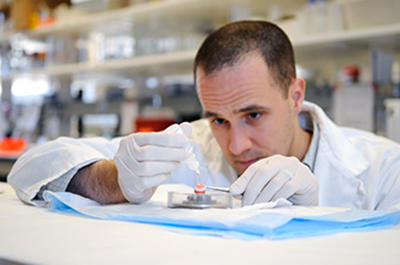
Associate professor Tannin Schmidt is cofounder of Lubris BioPharma.
University of Calgary
Sept. 20, 2016

Associate professor Tannin Schmidt is cofounder of Lubris BioPharma.
University of Calgary
Dry eye disease is a common condition affecting an estimated 25 per cent of Canadians. Symptoms include dry, itchy, uncomfortable eyes and visual disturbances, with potential damage to the surface of the eye. People who wear contact lenses, especially in a place like Calgary, with its high altitude and low humidity, can be particularly vulnerable.
Now a promising new treatment for dry eye is on the horizon. It’s the culmination of a decade of hard work — from discovery to lab research, partnerships and clinical trials — spearheaded by Tannin Schmidt, associate professor in the Faculty of Kinesiology and Schulich School of Engineering, Centre for Bioengineering Research and Education.
“Having a new treatment with such promising results is exciting, because it really could make a difference in people’s quality of life,” says Schmidt, a Tier 2 Canada Research Chair in Biomaterials, who co-discovered a protein, called lubricin, in the eye, when he was a PhD student in 2006 at the University of California San Diego. Lubricin — “essentially Mother Nature’s lubricant” — was first discovered in the knee in the 1970s. “When we discovered it in the eye, it was this whole new opportunity,” recalls Schmidt, who did much of the work to bring that discovery to fruition, while at the University of Calgary.
'Mother Nature's lubricant'
When he joined the University of Calgary as an assistant professor in 2008, Schmidt and his lab continued to do basic research on lubricin to demonstrate its importance and function as an ocular surface lubricant.
Schmidt is a cofounder for Lubris BioPharma, a company that has found a way to make a recombinant human form of the lubricin protein so that it would be safe to put in people’s eyes. As production scaled up, Lubris BioPharma partnered with Dompe, an Italian pharmaceutical company, which ran a clinical trial on lubricin last year, putting the recombinant human form of lubricin into a person for the first time with highly promising results — decreasing the signs and symptoms of dry eye. Read the news release.
Earlier this month, Schmidt presented his research at an international conference in Montpellier, France, hosted by the Tear Film and Ocular Surface Society. On the same day, a paper he co-authored on the clinical trial results was published online in The Ocular Surface, a peer-reviewed journal. The next step, Schmidt says, will be another large clinical trial of lubricin, which will likely take place next year.
Scope of research expanding
He’s looking at applying his research into other areas. Schmidt, who does contract work for Johnson and Johnson Vision Care, is researching how lubricin could be used to make contact lenses more comfortable to wear; and he’s working towards an arthritis trial, with the goal of being able to use lubricin injections to treat arthritis.
He’s also collaborating with cardiac surgeon Dr. Paul Fedak, a University of Calgary associate professor in the Cumming School of Medicine, Libin Cardiovascular Institute of Alberta, on preventing cardiac tissue adhesions post-surgery, which can complicate recovery in patients needing multiple heart surgeries, including open heart surgery patients, and children born with heart defects.
“It’s another example of collaborative basic research leading to new opportunities, and that’s all been done here at the University of Calgary,” Schmidt says, noting that the collaborative research of he and Fedak is funded by the Canadian Institutes of Health Research.
“Biomedical engineering is a strategic research priority at the University of Calgary, and the Faculty of Kinesiology is a great partner and key player in that cross-campus initiative.”
Funding from the Canada Foundation for Innovation and Alberta Economic Development and Trade contributed to this research.
The University of Calgary’s multidisciplinary Engineering Solutions for Health: Biomedical Engineering research strategy is focused on developing solutions for pressing health challenges in disease and injury prevention, diagnosis and treatments. We are also applying systems engineering principles to continuously improve the health system.